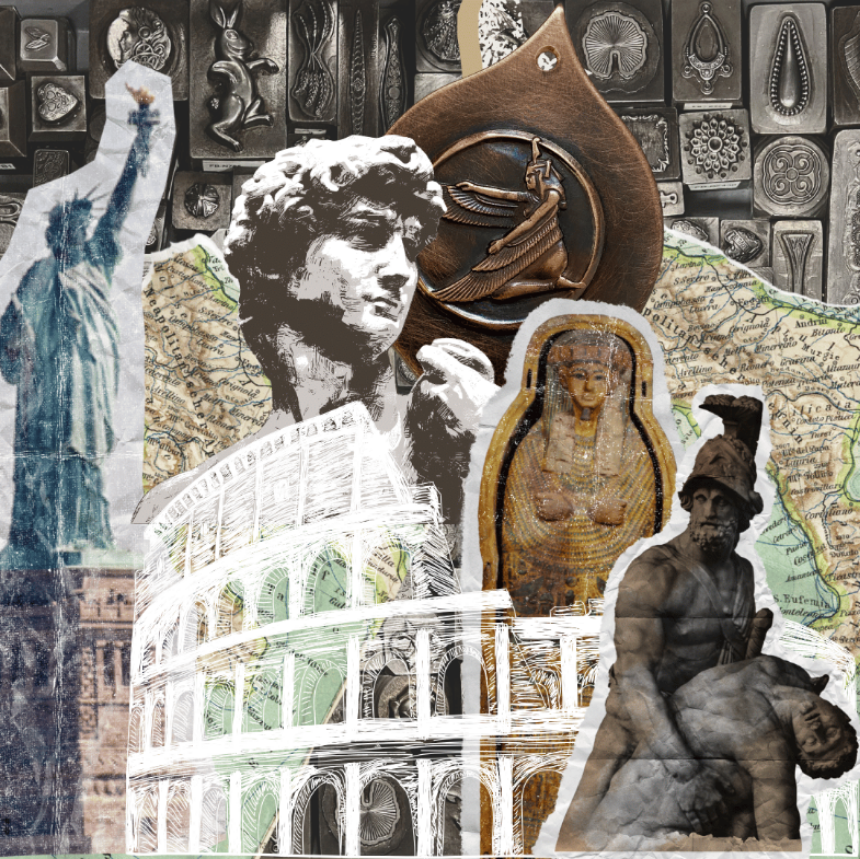
At Potter USA, we believe not only in preserving art history, but sharing it with the world–literally! We don’t hang all our jewelry hubs behind a glass window. The Industrial Revolution brought the jewelry to the everyman and in that same spirit, we bring these historic tools right to your door.
Featured in this week’s impression die spotlight are dozens of medallions, coins, and pins, all of which have a rich history that needs to be shared. Continue reading to learn about a few of our favorites!


1. Liberty Torch Pin, Attleboro, MA., USA, between 1875-1924
This was the original souvenir pin modeled after the Statue of Liberty, or Liberty Enlightening the World, by Frédéric Auguste Bartholdi from when France first gifted the statue to the United States of America. The pin was modeled after Bartholdi’s original design for the torch, but according to the Ellis Island Foundation, the torch underwent so many repairs after its installment that by 1931, it was virtually unrecognizable. In the 1980s, the torch was replaced altogether.


2. Owl of Attica, Attleboro, MA., USA, circa 1900
This large design is modeled after the famous "Owls of Attica," the silver tetradrachm coins minted in ancient Athens that eventually spread throughout the world as one of the most recognizable trade coins in history. The inscription in the bottom right reads, "ΑΘΕ,” an abbreviation of ΑΘΗΝΑΙΩΝ (Athenaion) which means "of the Athenians."


3. Ma’at, Attleboro, MA., USA, circa 1900
This medallion was made at the height of the Egyptian revival. It depicts the Egyptian goddess Ma'at–the personification of truth, justice, balance, and order–as she is depicted in the tomb of Nefertari. She was often depicted with an ostrich feather on her head and wings, but also as a feather. Ma’at represented the natural laws of the universe and how those laws are maintained by human beings. This sense of order and balance instilled in the ancient Egyptians their strong sense of morality and justice. More than simply a goddess, Ma'at was the set of principles that ancient Egyptians lived by. Ma’at as a code of ethics was an important part of achieving the Afterlife. The Egyptians believed that after the death of the body, a person was required to pass through the Hall of Judgment, where their heart was weighed on a scale against Ma’at’s feather of truth. If the deceased person’s heart balanced with Ma’at’s feather, they could continue their journey to the Afterlife. If not, their journey ended. This influenced the daily actions of the ancient Egyptians.


4. Star Maiden Bust, Attleboro, MA, USA, circa 1915
This design replicates the bust of Alexander Calder's "Star Maiden," which he sculpted in February of 1915 for the Panama-Pacific Exposition in San Francisco, California. The Star Maiden was modeled by Audrey Munson, who is considered to be America's first supermodel. You can still see the “Star Maiden” today in its hometown.


5. Philip II of Macedon Coin, Pforzheim, Germany, circa 1927
This coin was minted for the young Philip II, King of Macedonia and the father of Alexander the Great. The coin that this impression die is based on was made during the reign of Philip II (359 BCE - 336 BCE) and was emblematic of his military prowess. It depicts the god Apollo on the face and a figure, likely King Philip II himself, riding a horse-drawn chariot on the back. King Philip II began the rapid expansion of Macedonia into Greece, which was continued by his son after his assassination in 336 BCE. He was buried in the Great Tumulus at Aigai with abundant gold and treasure, though his tomb was the subject of controversy for many years.


6. Budai, Pforzheim, Germany, circa 1927
This three-dimensional design is a depiction of the Chan Buddhist monk Qici, also known as Budai (Bùdài in Chinese; Podae in Korean; Hotei in Japanese; Bố Đại in Vietnam), the "Laughing Buddha," or the "Fat Buddha." Budai was fondly-remembered as a jovial monk and was a very different historical figure from Gautama Buddah, the founder of Buddhism. His figure usually appears in Chinese and Japanese art as a happy and helpful figure that symbolizes contentment, luck, and abundance.


7. Discobolus, Pforzheim, Germany, circa 1927
This design is modeled after the Discobolus or Discus Thrower, a Classical Greek sculpture made by the Athenian sculptor Myron in 460–450 BC. Though first cast in bronze, the original is lost and the work known only through a number of Roman stone copies. The piece is emblematic of the combination of aesthetic beauty and athletic skill that was highly valued at this time in Greece. This design is one of a series of Greek revival sports medallions from Breuning in Pforzheim, Germany.


8. Apollo’s Chariot, Attleboro, MA., USA, circa 1969
This medallion depicts a Greco-Roman sun god, potentially Helios or Apollo, in his chariot, flying across the sky to usher in the morning. The chariot rides upon clouds pulled by four horses. Though we were unable to discover the original use for this hub, its theme and style is consistent with a number of lunar landing collectible medallions that were created by the same company between 1961 and 1972 in honor of the Mercury, Gemini, and Apollo missions.
Written by Aeden Soland
